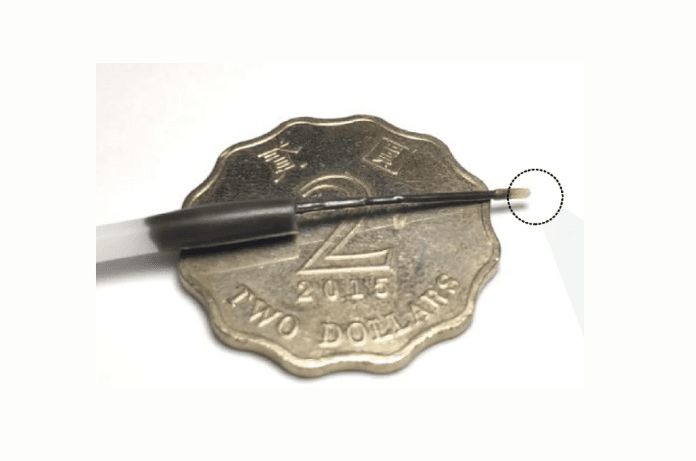In a significant leap forward for medical technology, researchers at the School of Engineering at the Hong Kong University of Science and Technology (HKUST) have introduced the world’s smallest multifunctional biomedical robot. It is just 0.95 mm in diameter. This tiny innovation is 60% smaller than current endoscopic robots. Still, it boasts a suite of powerful capabilities. Headed by Prof. Shen Yajing, Associate Professor in the Department of Electronic and Computer Engineering (ECE), this miniature marvel promises to transform interventional diagnosis and treatment in medicine.
This robot’s ultra-slim profile represents more than just an engineering triumph. It marks a breakthrough in navigating the most intricate channels of the human body. Difficult-to-reach areas, such as the lung’s end bronchi and the oviducts, could now be explored and treated with unprecedented precision. The biomedical robot achieves a remarkable trifecta of functionalities—imaging, high-precision motion, and multifunctional operations—within a single device, an accomplishment the research team describes as achieving the “impossible trinity.”
Advancements in Design and Functionality
One of the robot’s most impressive features is its ability to extend obstacle detection to approximately 9.4 mm. This smallest robot improved 10 times over existing theoretical limits. With motion precision at less than 30 μm, it significantly expands the imaging region by around 25 times the standard field of view. These advancements enhance the robot’s maneuverability in tight spaces and its ability to deliver clear imaging and precise treatments in areas previously deemed inaccessible.
This biomedical robot is multifunctional and capable of imaging, sampling, drug delivery, and laser ablation. Its broad range of applications positions it as a versatile tool in modern medicine, streamlining diagnostic and therapeutic procedures into a single operation. The competitive imaging performance, coupled with precise treatment delivery, paves the way for groundbreaking advancements in minimally invasive surgeries.
Key Components Of Smallest Bio-Medical Robot
The success of the smallest biomedical robot is rooted in four key components. Each component is crucial to its compact yet powerful design.
- An optical fiber array captures high-quality images from within the body, essential for accurate diagnostics and navigation.
- A custom tool ensures treatments are delivered with pinpoint precision and minimizes damage to surrounding tissues.
- A hollow skeleton fabricated using a microscale 3D printer, securely holds the fibers and tools in place, maintaining the robot’s structural integrity.
- A functionalized skin is created through a magnetic spray technique. It enables precise movement control.This skin, combined with a gel-like outer layer reduces friction. It ensures the robot can glide smoothly within the body during surgical procedures.
This intricate combination of components allows the biomedical robot to remain small while performing complex tasks efficiently.
The HKUST research team is committed to further refining the robot’s design for practical clinical use. Dr. Zhang Tieshan, a postdoctoral fellow and co-first author of the study, along with Dr. Li Gen, highlighted their dedication to optimizing the robot’s design and control to ensure safety and reliability in interventional surgeries. He noted, “We aim to further enhance the design and control of the fiberscopic robot, prioritizing safety and reliability during surgeries. We look forward to conducting in vivo trials to validate its performance in clinical settings.”
Clinical Potential and Future Applications
The robot’s capabilities have been successfully demonstrated in vitro bronchial models and ex-vivo porcine lungs. There it navigated through tight spaces, captured high-resolution images, and executed treatments in challenging locations. Prof. Shen emphasizes the robot’s immense potential for clinical applications, stating, “Our study provides a viable solution for developing a surgical robot aimed at achieving early diagnosis and therapeutic goals in hard-to-reach areas of the body. With continued technological progress, we believe the fiberscopic robot will significantly enhance human health shortly.”
The collaborative efforts of the research team, including Research Assistant Professor Dr. Yang Xiong and Ph.D. student Zhao Haoxiang, reflect the innovative spirit propelling this project. As the team moves toward in vivo trials, the potential for this smallest biomedical robot to revolutionize medical procedures becomes increasingly apparent.
Looking Ahead
Small-scale continuum robots have already proven their versatility in medical treatments, from heart disease interventions using stents and electrophysiology catheters to repairing perforations in gastric and duodenal ulcers through single-port laparoscopy. HKUST’s latest invention builds on these successes, surpassing existing models in size, precision, and multifunctionality.
This study underscores significant strides in biomedical engineering and the promising future of small continuum robots. These biomedical robots are capable of navigating through narrow cavities and offering minimal infection risks. These tiny bio-medical advancements are not merely a technological feat but a beacon of hope for less invasive, more effective medical procedures in the coming years.

